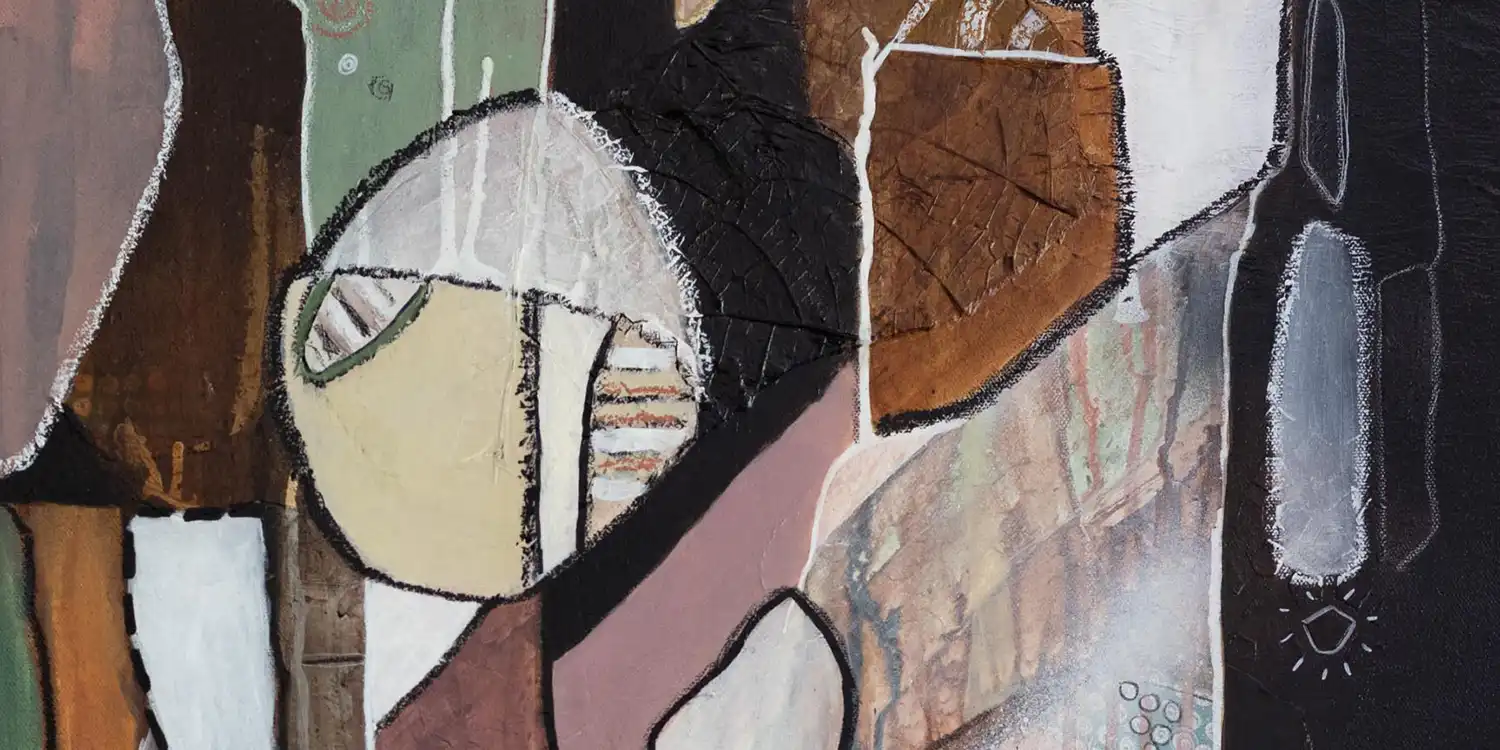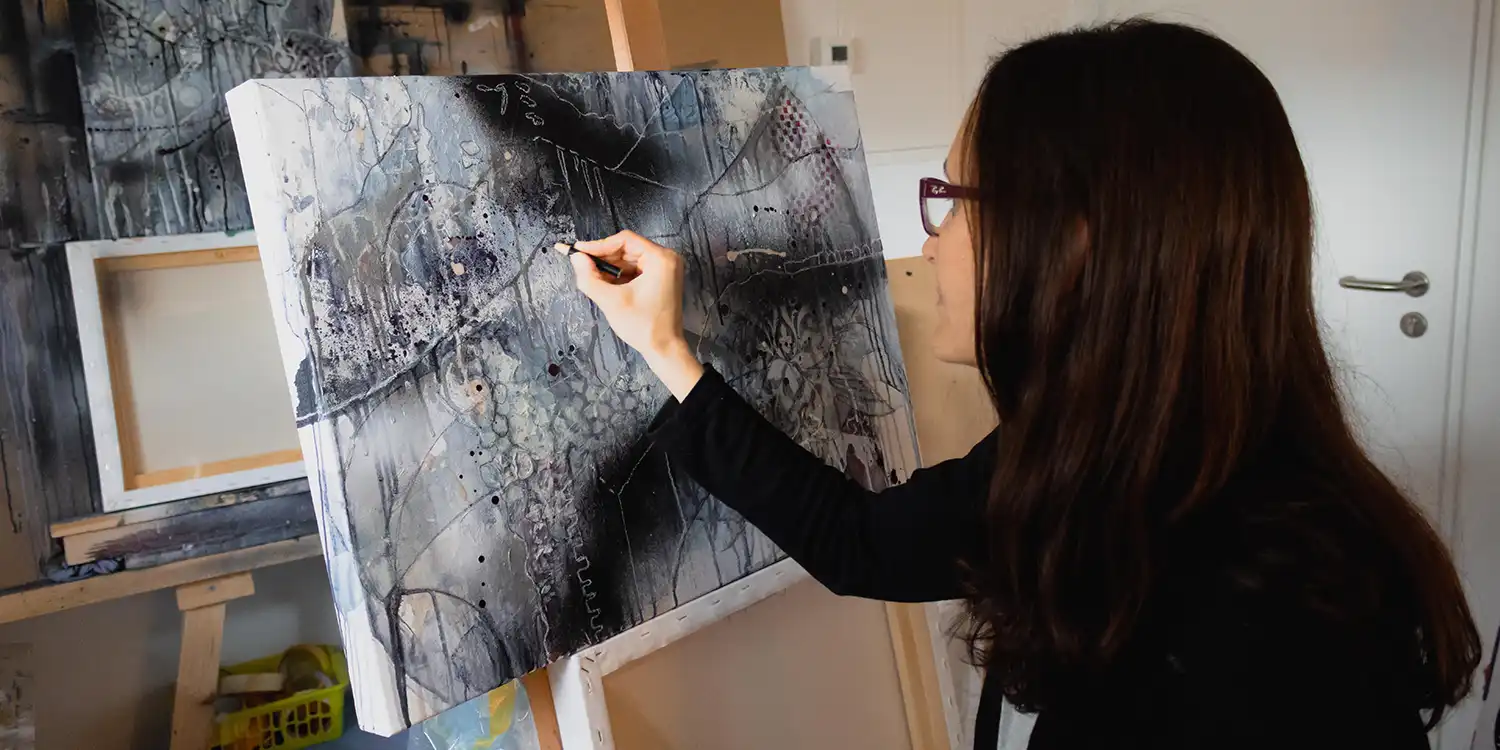Working in series to create coherent works of art and devote yourself specifically to a theme. About the advantages of art in series and famous examples.

Abstract forms: The Magic of Small & Large Elements in Abstract Art
The Dance of Form and Space
Embracing Negative Space
In the world of abstract art, understanding the interplay between small and big forms is similar to a dance between positive and negative space. Negative space, the areas around and between forms, is as crucial as the forms themselves.
Allow your eyes to wander not just on the shapes but also in the spaces in-between. This dynamic relationship creates a visual rhythm, giving the composition a sense of movement and balance.
The Art of Balance
Successful abstract compositions achieve a delicate equilibrium between small and big forms. Strive for a harmonious distribution of visual weight, preventing the dominance of one over the other.
Balance doesn’t imply symmetry; it’s about creating a satisfying arrangement where each form contributes to the overall aesthetic without overshadowing its counterparts. Think of it as orchestrating a symphony of shapes and spaces.

Each abstract element contributes to the harmony of the overall composition with its shape and size.
Crafting Expressive Small Forms
Small Forms, Big Impact
Small forms in abstract art act as intricate details, adding nuance and depth to the composition. Think of them as the punctuation marks in a sentence – they may be small, but they have significant influence.
Experiment with various shapes, textures, and colors in your small forms. They serve as focal points, drawing the viewer into the complex details and allowing for a more intimate connection with the artwork.
Avoiding Overcrowding
While small forms are essential, beware of overcrowding your composition. Each element should have room to breathe, allowing the viewer’s eyes to navigate the artwork effortlessly.
Overcrowding can lead to visual chaos and detract from the overall impact of the piece. Aim for a thoughtful arrangement where each small form contributes meaningfully without overwhelming the viewer.

Small forms in different colors serve as a complement to the larger element in the abstract work of art.
Commanding Presence with Big Forms
The Bold Statement
Big forms are the anchors of an abstract composition, commanding attention and establishing a focal point. These larger elements serve as the backbone, providing structure and guiding the viewer’s gaze.
Experiment with bold shapes and vibrant colors to create a powerful visual impact. Big forms set the tone for the entire artwork, dictating its mood and overarching theme.
Striking a Delicate Balance
While big forms carry visual weight, avoid the pitfall of dominance. A successful composition finds a balance where large forms complement rather than overshadow smaller counterparts.
Think of it as a conversation between elements – each big form contributing to the narrative without drowning out the subtleties of the smaller details. Striking this balance ensures a captivating and harmonious visual experience.

Large forms serve as a focal point and guide the viewer through the picture. They should not overshadow the smaller elements.
A Guide for Art Enthusiasts
Observing Abstract Art
When exploring abstract artworks, train your eyes to recognize the dialogue between small and big forms. Take a step back to absorb the composition as a whole, then dive into the details. Note how the artist employs negative space, and observe the strategic placement of both small and big forms. This mindful observation enhances your appreciation for the artist’s skill in orchestrating visual elements.
Navigating Visual Dynamics
As you dive into the world of abstract art, pay attention to how your eyes move across the composition. Are they drawn to specific small forms or guided by prominent big forms? Understanding the visual dynamics enriches your connection with the artwork, allowing you to appreciate the intentional choices made by the artist in crafting a captivating composition.
With a little distance, large forms can be discovered that guide the eye through the work of art. On closer inspection, you immerse yourself in the details and learn to understand the composition and dynamics.
Creating Your Own Abstract Artwork
Experimenting with Form and Composition
Armed with the knowledge of small and big forms, start your journey to create captivating abstract art. Experiment with shapes, sizes, and negative space. Let your intuition guide you as you find the delicate balance between subtlety and boldness.
Remember, the magic lies not just in the forms themselves but in the nuanced relationship they share within the composition. With practice, you’ll discover the artistry of crafting visually fascinating abstract creations.

Arranging small and large abstract shapes is a process and involves a lot of contemplation and “feeling”.
Share this post
More interesting articles for you…
Advantages of Online Galleries for Buying & Selling Art
About online galleries and art platforms, the advantages of buying art on the web, as well as an insight into my own profile on Singulart.
Hanging Artworks: A Guide to Using Wire for Your Canvas
How to simply attach a wire hanger to your canvases and hang them up directly. Step-by-step instructions with pictures and material list.
Art on the Wall: Five Creative Arrangement Styles for Any Room
Five creative arrangement styles for artwork on your walls. Get to know different ways of hanging art and designing your walls. From classic to experimental.
Buying art at art fairs and exhibitions
What a visit to an art fair or exhibition brings: as an artist to offer his art and as an art lover to buy exclusive works of art.
5 Signs You Should Buy Art
Various signs that it’s time to consider buying a work of art. When is the best time to buy art and why you might need a work of art to fulfill your wishes.







